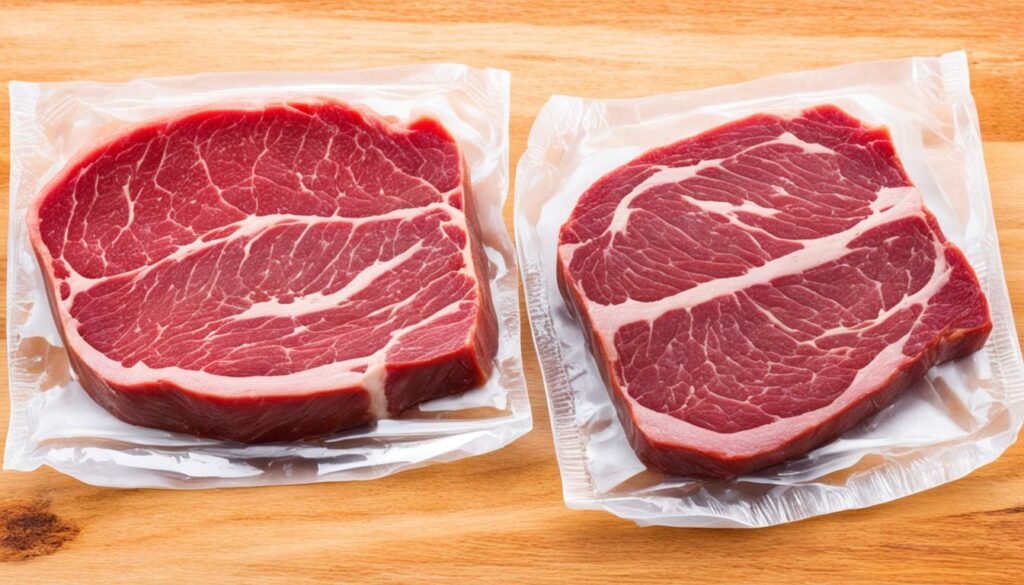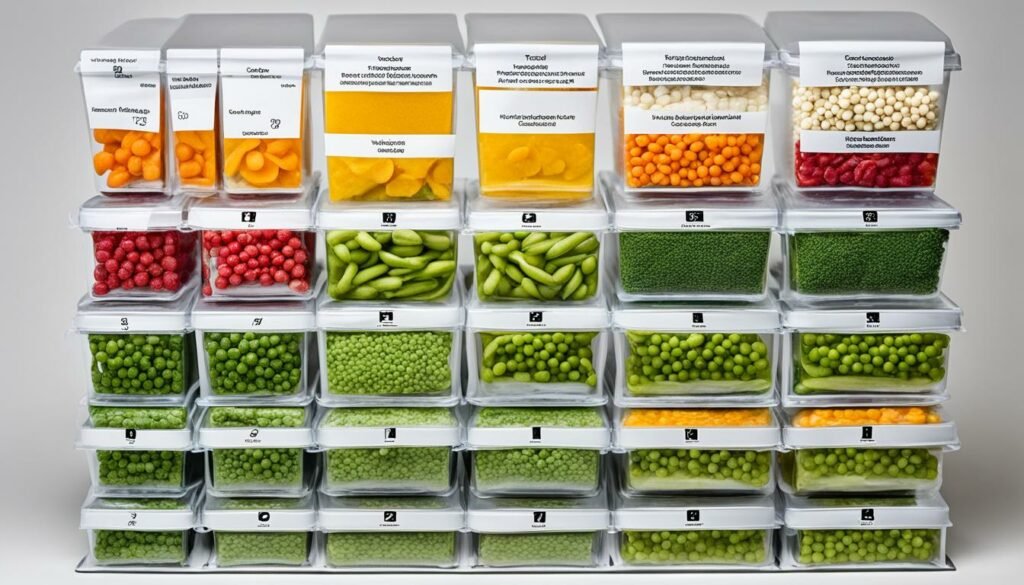I’ve always been intrigued by the best ways to keep my food fresh and nutritious. That’s why I’m delving into the world of food preservation methods, particularly vacuum sealing versus freezing. These techniques are widely used to extend shelf life and minimize nutrient loss.
Vacuum sealing is a contemporary approach that eliminates air from packaging, thereby slowing bacterial growth. In contrast, freezing is a traditional method that halts enzymatic reactions. Both aim to maintain food’s flavor, texture, and nutrients over extended periods.
This article will delve into how these methods compare in terms of nutrient retention and effectiveness. We’ll delve into the science of food preservation to determine which method suits your kitchen best.
Understanding Food Preservation Methods
Mastering food preservation is essential for anyone aiming to cut down on waste and keep meals nutritious. Proper storage techniques can greatly enhance the quality and shelf life of groceries. Let’s delve into the realm of food preservation methods and see how they help maintain our food’s freshness and nutritional content.
The Importance of Proper Food Storage
Correct storage is vital for preventing nutrient loss and preserving flavor. Neglecting proper storage can lead to food waste and diminished nutritional value. By employing effective preservation techniques, we can extend the shelf life of groceries, ensuring they remain safe and nutritious for longer.
Common Food Preservation Techniques
Several effective food preservation methods are at our disposal:
- Vacuum sealing: Removes air to prevent oxidation
- Freezing: Slows down enzymatic reactions
- Canning: Uses heat to kill bacteria and create a seal
- Dehydration: Removes moisture to inhibit microbial growth
The Science Behind Food Spoilage
Grasping the science of food spoilage aids in selecting the most suitable preservation method. Spoilage stems from three primary causes:
| Factor | Effect | Prevention Method |
|---|---|---|
| Bacterial growth | Causes decay and potential illness | Refrigeration, freezing |
| Enzymatic reactions | Changes in texture and flavor | Blanching, freezing |
| Oxidation | Rancidity in fats, color changes | Vacuum sealing, antioxidants |
Employing these preservation methods significantly reduces nutrient loss and sustains food quality over time. It’s intriguing to observe how simple techniques can profoundly impact our daily lives and dietary habits.
Vacuum Sealing: A Modern Approach to Food Preservation
Vacuum sealing has transformed the way we store food, offering a modern solution for maintaining food quality and extending its shelf life. This method has proven to be highly effective in keeping my groceries fresh and minimizing food waste.
How Vacuum Sealing Works
The process is straightforward yet brilliant. A vacuum sealer eliminates air from bags or containers, creating a space devoid of oxygen. This absence of air hinders the growth of bacteria and mold, thereby preventing oxidation and maintaining food freshness for a longer period.

Benefits of Vacuum Sealing
Vacuum sealing presents numerous benefits:
- Shelf life extension: Foods can last up to five times longer
- Oxidation prevention: Keeps food from spoiling or changing color
- Flavor preservation: Locks in taste and aroma
- Space-saving: Compact storage in fridge or freezer
- Cost-effective: Reduces food waste and allows bulk buying
Types of Vacuum Sealers
There are several types of vacuum sealers available:
- External sealers: Affordable and ideal for home use
- Chamber sealers: Perfect for commercial kitchens and frequent use
- Handheld sealers: Portable and great for small items or resealing bags
With these options, you can select the most suitable vacuum sealer for your needs and enjoy the extensive benefits of vacuum sealing in your kitchen.
Freezing: A Traditional Method of Food Preservation
Freezing has been a cornerstone of food preservation for generations. It’s proven to be an effective method for keeping nutrient-dense foods fresh over extended periods. By slowing enzymatic reactions, it helps maintain the nutritional value of fruits, vegetables, and meats.
One of the key benefits of freezing is its ability to halt microbial growth. This process effectively stops bacteria and other harmful microorganisms from multiplying, ensuring food safety. When done correctly, freezing can preserve food for months without a significant loss of quality.
However, freezing is not without its drawbacks. Ice crystals that form during freezing can damage cell walls, leading to changes in texture upon thawing. This is particularly noticeable in fruits and vegetables, which may become softer or mushier.
| Food Type | Freezing Benefits | Freezing Drawbacks |
|---|---|---|
| Fruits | Preserves vitamins | Texture changes |
| Vegetables | Retains minerals | Potential nutrient loss |
| Meats | Extends shelf life | Risk of freezer burn |
Freezer burn is another concern when freezing foods. It occurs when moisture escapes from the food’s surface, leaving behind dry, discolored patches. While not harmful, freezer burn can affect taste and texture. To prevent this, I always ensure foods are tightly wrapped or stored in airtight containers before freezing.
Overall, freezing remains a reliable method for preserving nutrient-dense foods. By understanding its strengths and limitations, we can make the most of this traditional preservation technique.
Nutrient Retention: Vacuum Sealing vs. Freezing
Both vacuum sealing and freezing are effective for preserving food, each with its own advantages for nutrient retention. Let’s delve into how these methods compare in maintaining vitamins, minerals, and flavors.
Impact on Vitamin and Mineral Content
Vacuum sealing is top-notch for keeping vitamin and mineral content intact by sealing out air. This method retains 3-5 times more nutrients than conventional storage. Freezing also works well but might lead to some nutrient loss due to enzymatic reactions.

Effects on Flavor and Texture
Vacuum sealing outshines in flavor retention. It seals in the food’s natural tastes and smells, preventing oxidation that can spoil flavors. Freezing, however, might change the texture of fruits and vegetables due to ice crystal formation.
Long-term Storage Considerations
For long-term storage, combining vacuum sealing and freezing is the best approach. Vacuum sealing before freezing adds an extra shield against freezer burn and nutrient loss.
| Storage Method | Nutrient Retention | Flavor Preservation | Texture Maintenance |
|---|---|---|---|
| Vacuum Sealing | Excellent | Superior | Very Good |
| Freezing | Good | Good | Fair |
| Vacuum Sealing + Freezing | Excellent | Very Good | Good |
Practical Applications: When to Use Each Method
Deciding on the best food preservation method can be complex. Knowing when to employ vacuum sealing or freezing significantly impacts food quality. Let’s delve into the ideal scenarios for each technique and how they can be combined for superior outcomes.
Best Foods for Vacuum Sealing
Vacuum sealing is particularly beneficial for preserving dry goods, cheeses, and cured meats. It excels by removing air and thus preventing oxidation, which keeps these items fresh. I frequently utilize my vacuum sealer for marinating meats, as it infuses flavors more effectively and quickly.
Ideal Scenarios for Freezing
Freezing is ideal for fruits, vegetables, and raw meats. Although it may lead to texture changes in some foods, it effectively preserves nutrient-dense items for longer periods. I freeze berries and leafy greens to enjoy their nutritional benefits throughout the year.
Combining Both Methods for Optimal Results
Combining vacuum sealing and freezing yields the best results. This method offers comprehensive protection against freezer burn and nutrient depletion, crucial for the long-term storage of meats and other valuable foods. Vacuum sealing before freezing ensures my food remains fresh and retains its quality for months.
| Food Type | Best Preservation Method | Benefits |
|---|---|---|
| Dry Goods (rice, pasta) | Vacuum Sealing | Prevents moisture and pests |
| Berries and Vegetables | Freezing | Maintains nutrients and convenience |
| Raw Meats | Vacuum Sealing + Freezing | Prevents freezer burn, extends shelf life |
| Herbs | Vacuum Sealing | Preserves flavor and aroma |
Conclusion
I’ve delved into the realm of food preservation, comparing vacuum sealing with freezing. Both methods are essential for maintaining the freshness and nutritional value of our food. Vacuum sealing excels in preserving flavors and preventing oxidation. In contrast, freezing provides a straightforward and adaptable approach for a wide array of foods.
Regarding nutrient retention, each preservation method has distinct advantages. Vacuum sealing is effective in safeguarding vitamins and minerals by minimizing air contact. Freezing, when executed swiftly, can also preserve nutrients effectively. The decision between these methods often hinges on the type of food and its intended storage duration.
My research suggests that integrating vacuum sealing and freezing can significantly enhance food preservation. This combination is ideal for long-term storage, ensuring that food remains of high quality and nutrient-rich. Whether you’re preparing meals in advance or storing seasonal produce, understanding these techniques will enable you to enjoy fresher, more nutritious meals throughout the year.
FAQ
What are the key differences between vacuum sealing and freezing when it comes to nutrient retention?
Vacuum sealing outperforms in preventing oxidation, which can diminish certain vitamins and nutrients. Freezing may lead to some nutrient loss due to enzymatic reactions, but this loss is typically minimal. Vacuum sealing excels in maintaining flavor and texture, especially for extended storage periods.
How do vacuum sealing and freezing work to preserve food?
Vacuum sealing eliminates air from the package, creating an environment devoid of oxygen. This environment hampers bacterial growth and oxidation. Freezing, by contrast, slows enzymatic reactions and microbial growth. It preserves food by reducing the temperature.
What are the benefits of vacuum sealing over traditional methods like freezing?
Vacuum sealing extends shelf life by up to 4 times, prevents freezer burn, and retains flavor and nutrients better than freezing alone. It is particularly beneficial for meat, cheese, and dry goods.
Can vacuum sealing and freezing be combined for optimal food preservation?
Indeed, combining vacuum sealing with freezing can offer the best protection against freezer burn and nutrient loss. This method is especially effective for the long-term storage of meats and other high-value foods.
What types of foods are best suited for vacuum sealing or freezing?
Vacuum sealing is best for dry goods, cheeses, and cured meats, as well as for quick marinating of meats. Freezing is suitable for most fruits, vegetables, and raw meats. The choice of method depends on the food type, storage duration, and desired quality.
How can proper food storage methods help reduce food waste and save money?
By prolonging the shelf life of food and preventing spoilage, vacuum sealing and freezing can significantly reduce food waste. This can lead to savings of up to 325€ per year for a household.
